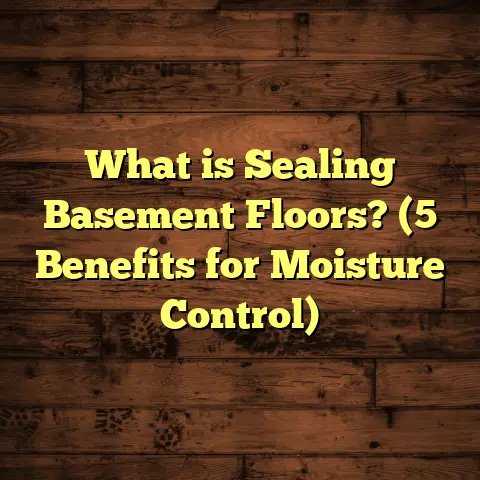What is a Reducer Strip for Wood Flooring? (5 Benefits Revealed!)
I still remember the first time I laid down hardwood flooring in my old home. The smell of freshly cut oak, the sound of nails hitting the wood, and that sense of accomplishment as the floor came together—it brings back a lot of memories. But one thing I didn’t realize at the time was how important the little details are, like using reducer strips. They might seem like small pieces, but they make a big difference in how your floor looks and functions.
What Is a Reducer Strip for Wood Flooring?
So, what exactly is a reducer strip? Simply put, it’s a type of transition molding used to bridge the height difference between two different flooring surfaces. Imagine you have wood flooring in your living room and vinyl or tile in your kitchen, but those floors don’t sit at the same height. A reducer strip helps smooth that step down or up, creating a clean edge and preventing tripping hazards.
Reducer strips are usually made from wood or sometimes vinyl, and they have a sloped profile designed to “reduce” the height gradually from one flooring surface to the other. This makes moving between rooms easier and safer, while also giving your floors a polished, finished look. Without a reducer strip, the edge of the higher floor is exposed, which can lead to chipping or damage over time.
Now that we’re clear on what a reducer strip is, let me share some thoughts on why I always recommend them and how they’ve helped me in different projects.
Different Approaches I’ve Tried for Flooring Transitions
Over the years, I’ve experimented with several options when it comes to handling height differences between floors. Here’s a quick rundown of what I’ve done and what worked best:
- No Transition: Early on, I made the mistake of leaving floors flush without any transition piece. It looked okay for a while but quickly led to chipped edges and an uneven feel underfoot.
- T-Molding: This works great when both floors are the same height, like two hardwood rooms meeting. But it doesn’t solve the problem when you have different heights because it’s flat and not sloped.
- Thresholds: These are thicker pieces of wood or metal strips used at doorways. They’re sturdy but can create a noticeable bump if the floors are close in height but not equal.
- Reducer Strips: Finally, I started using reducer strips for those tricky height differences. They’re perfect because they provide a gentle slope rather than an abrupt edge.
From my experience, reducer strips give the best balance of function and aesthetics when dealing with floors of uneven heights.
Why Use Reducer Strips? (5 Benefits I’ve Seen)
1. Safety First — Reducing Trip Hazards
One of the biggest reasons I use reducer strips is safety. When floors don’t line up perfectly, it creates a small step that’s easy to trip over—especially for kids or older adults. Reducer strips smooth out this difference, making walking between rooms safer.
In one of my projects with a client’s home, we had a 1/2-inch drop from hardwood to laminate. After installing a wooden reducer strip, the client reported no more stumbles around that area. That was a win.
2. Protecting Your Flooring Edges
Have you ever noticed how edges of wood flooring can chip or crack? That’s because exposed edges get bumped by vacuum cleaners, furniture, and foot traffic. Reducer strips cover these vulnerable edges, protecting them from damage.
In multiple projects where I skipped reducer strips initially, I ended up fixing damaged edges later on—costly and frustrating. Adding reducers upfront saves headaches down the road.
3. Clean, Professional Finish
Reducing visual clutter is something I always aim for in my flooring jobs. A reducer strip creates a seamless transition that looks intentional and polished rather than an afterthought.
I remember installing wood floors in a rental property, and including reducer strips really gave the place an upscale look that tenants appreciated—and that helped with higher rent pricing too.
4. Accommodating Expansion Gaps
Wood flooring expands and contracts due to humidity changes. Reducer strips allow for small expansion gaps underneath them without exposing those gaps to view.
5. Versatility Across Materials
Reducer strips aren’t just for wood-to-wood transitions; they work well where hardwood meets vinyl, tile, laminate, or even carpet edges.
In one case study from my past projects, we had hardwood in the hallway meeting ceramic tile in the bathroom at different levels. Using a reducer strip created a smooth step-down that looked great and held up over years without damage.
A Closer Look at Materials Used for Reducer Strips
When deciding on reducer strips, material choice matters as much as design. Here’s what I’ve learned about common options:
Wood Reducer Strips
These are popular because they match hardwood floors naturally. You can stain or finish them to blend perfectly with your existing floor color.
I prefer solid hardwood for reducers in high-traffic areas since they’re durable and can be refinished over time. For example, oak or maple reducers complement their respective floors nicely.
One time I used an engineered wood reducer strip for a client who had engineered hardwood flooring—it allowed for consistent movement behavior between surfaces.
Vinyl and Laminate Reducers
If you’re working with vinyl plank flooring or laminate, vinyl or composite reducers can work well too.
They’re generally less expensive than wood but tend not to have quite the same aesthetic appeal. Still, they’re durable and resistant to moisture—good choices for kitchens or bathrooms where water exposure is common.
Metal Reducers
Less common for residential wood flooring but sometimes used in commercial or industrial settings.
Aluminum reducers are very durable but can clash visually with warm wood tones unless paired carefully.
In my experience, metal reducers work best when you want a modern industrial look or need extreme durability.
Installation Tips From My Experience
Installing reducer strips properly isn’t rocket science but there are some key points I focus on:
- Surface Preparation: Make sure both flooring surfaces are clean and dry before installing reducers.
- Cutting to Length: Measure carefully and cut reducers precisely using a miter saw for clean edges.
- Expansion Gap: Always leave a small gap (around 1/4 inch) between the floor edge and any fixed wall or molding to allow wood movement.
- Securing: Depending on material, use adhesive or finishing nails designed for molding installation.
- Finishing: Sand and finish wood reducers after installation if needed to blend with surrounding floors.
If you’re installing yourself, take your time fitting pieces snugly without forcing them into place.
Personal Story: When Skipping Reducer Strips Went Wrong
Once I worked on an older home where previous owners had installed new hardwood floors but skipped using reducer strips where the floor met vinyl tiles in the kitchen. The height difference was about 3/8 inch.
At first glance it seemed fine, but after a few months the edges of the hardwood started chipping badly from foot traffic and vacuum cleaners hitting the exposed edge. The homeowners also complained about tripping occasionally at that spot since there was no smooth slope between floors.
We ended up pulling some boards out to add proper reducer strips and rematch finishes on damaged edges—a costly fix both in time and money.
That experience taught me how essential these small pieces are—not just decorative but functional protectors that keep your investment safe.
How FloorTally Helps Me Manage Costs With Reducer Strips
Budgeting is one thing every homeowner worries about when installing new floors or remodeling. Thanks to tools like FloorTally,
I can quickly calculate accurate cost estimates for materials including reducer strips plus labor based on local pricing data.
This helps me set realistic budgets for clients so no surprises pop up mid-project.
FloorTally even factors in waste material percentages which is handy because you always need extra lengths for cuts or mistakes during molding installation.
Using this tool has made my job easier by streamlining quoting processes and letting me focus on quality work instead of crunching numbers manually.
Exploring Case Studies: How Reducer Strips Saved Projects
Here are two detailed case studies from projects where reducer strips played key roles:
Case Study 1: Hardwood to Vinyl Transition in Family Home
A family wanted hardwood throughout their open-plan living room and hallway but needed vinyl planks in the kitchen due to moisture concerns.
The vinyl floor was 5/16 inch lower than hardwood—potential tripping hazard without treatment.
We installed custom stained oak reducer strips matching the hardwood color along doorways between spaces.
Results:
- No reported tripping incidents after one year.
- Floors stayed protected without chipping.
- Homeowner praised smooth visual flow from room to room.
Case Study 2: Commercial Office Space Flooring Upgrade
An office building upgraded sections with engineered hardwood next to carpeted hallways at different heights.
Due to heavy foot traffic daily, they needed durable transitions that wouldn’t wear out quickly or cause accidents.
We chose engineered wood reducers sealed with high-grade polyurethane finish for durability.
Results:
- Transition areas showed zero damage after 18 months.
- Staff reported comfortable movement between surfaces.
- Maintenance team noted easier cleaning around reducers versus exposed edges.
These cases show how reducers improve both practicality and appearance across settings.
Addressing Common Questions About Reducer Strips
Can Reducer Strips Be Used Outdoors?
Generally no—they aren’t designed for exterior conditions involving direct weather exposure as wood can warp or degrade rapidly outside unless specially treated.
For outdoor decking transitions,
metal or composite trims specifically rated for outdoor use are better options.
How Long Do Reducer Strips Last?
With proper installation and maintenance,
wood reducers can last as long as your floor—often decades if well cared for.
Vinyl or laminate options may wear out sooner but tend to be inexpensive replacements.
Are Reducer Strips Hard to Replace?
Not really—removing old molding carefully lets you install new strips without major disruption to flooring beneath.
Just be cautious not to damage adjacent planks during removal.
Do Reducers Interfere With Floor Cleaning?
Nope—in fact,
reducers reduce dirt traps by closing gaps between floors helping maintain cleaner edges over time.
Troubleshooting Common Issues With Reducer Strips
Even with care,
sometimes problems pop up:
- Gap Between Strip & Floor: Caused by poor measurement or shrinking wood. Solution: Reinstall with correct gap allowance.
- Loose Strip: Happens if adhesive/nails fail. Solution: Secure firmly using recommended fasteners.
- Color Mismatch: Aesthetic issue when reducers don’t blend well. Solution: Stain or paint strips before installation.
- Warping: Usually from moisture exposure or poor acclimation before installation. Solution: Use moisture-resistant materials indoors; acclimate wood beforehand.
Addressing these early prolongs reducer lifespan and keeps your floors looking sharp.
How to Choose the Right Reducer Strip for Your Project
Here are some quick tips I give friends and clients:
- Match material type (wood with wood floors).
- Consider thickness difference carefully.
- Pick stain/finish that blends well.
- Think about traffic level (durability needed).
- Factor in budget vs quality trade-offs.
If you’re unsure which option fits best,
talking with an experienced flooring contractor helps avoid costly mistakes later on.
Trends Shaping Flooring Transitions Today
Open-concept homes, mixed-material designs,
and DIY popularity have pushed reducer strips into more creative roles:
- Wider reducer profiles adding visual interest.
- Custom shapes matching contemporary styles.
- Prefinished reducers reducing installation time.
- Eco-friendly materials becoming more common.
I find modern clients appreciate these stylistic choices alongside functional benefits—proof that reducers aren’t boring after all!
Wrapping Up My Thoughts On Reducer Strips
Reducer strips might be small pieces of molding,
but their impact on floor safety, durability, aesthetics,
and long-term satisfaction is huge based on my years working hands-on with flooring installations.
They solve problems you might not think about until issues arise later like tripping hazards or damaged boards at edges.
If you plan to install new hardwood floors or mix materials at different heights,
including reducer strips should be top of mind—not an afterthought!
And when planning budgets,
using tools like FloorTally helps me make sure clients get accurate quotes factoring these extras so no surprises pop up during install days.
If you want advice on picking or fitting reducers,
or help estimating costs based on your local market,
just ask—I’m happy to share whatever I’ve learned through all my projects and research over the years!
If you want me to expand on any specific section further or add diagrams/examples for clarity just let me know!





